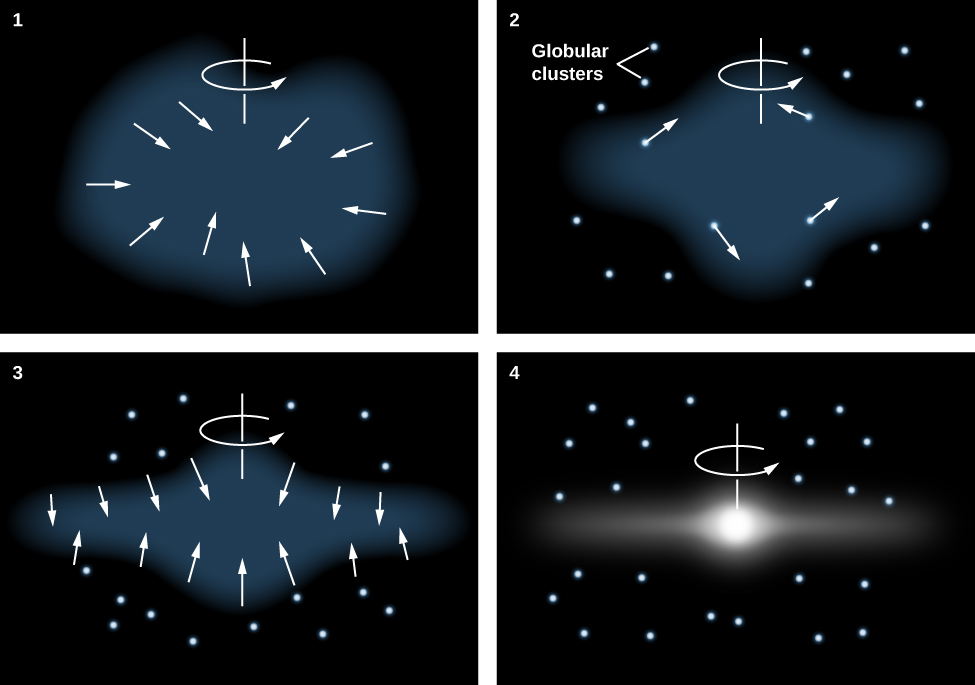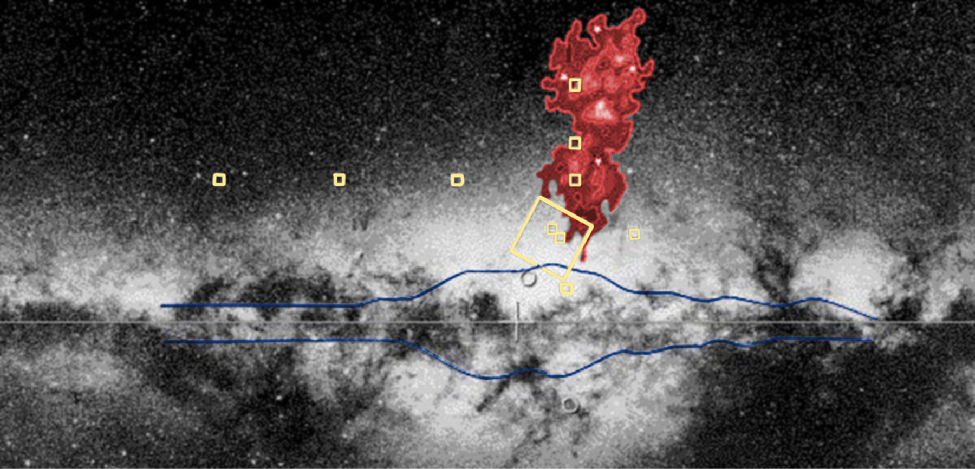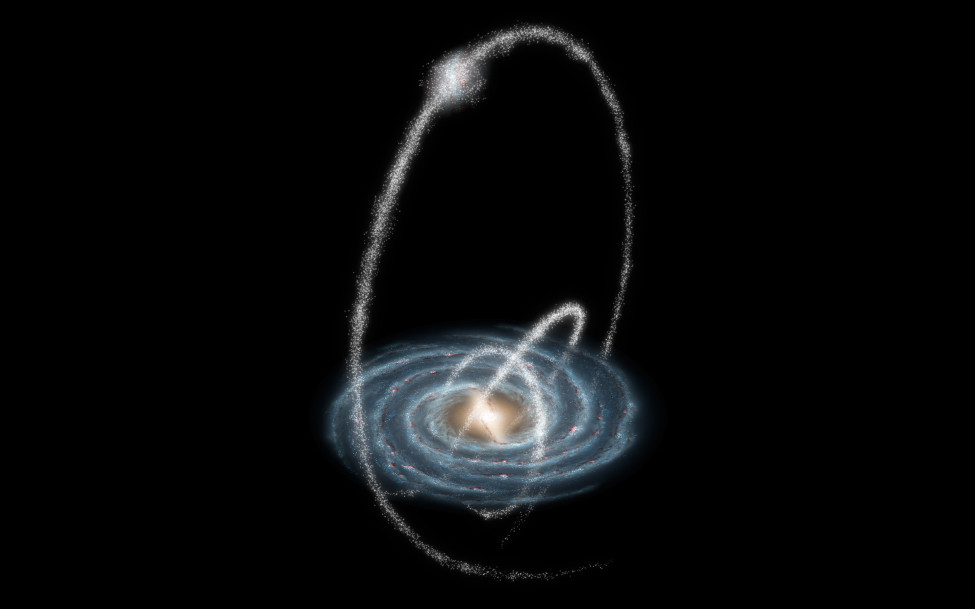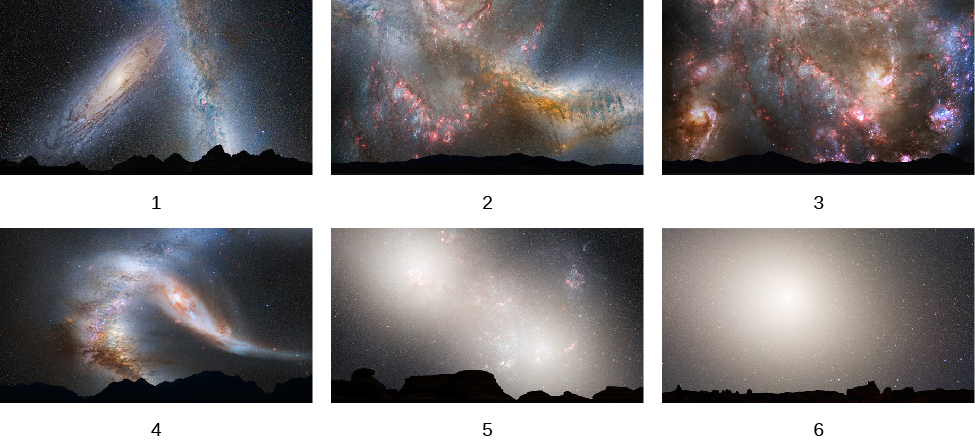Chapter 25 The Milky Way Galaxy
25.6 The Formation of the Galaxy
Learning Objectives
By the end of this section, you will be able to:
- Describe the roles played by the collapse of a single cloud and mergers with other galaxies in building the Milky Way Galaxy we see today
- Provide examples of globular clusters and satellite galaxies affected by the Milky Way’s strong gravity.
Information about stellar populations holds vital clues to how our Galaxy was built up over time. The flattened disk shape of the Galaxy suggests that it formed through a process similar to the one that leads to the formation of a protostar (see The Birth of Stars and the Discovery of Planets outside the Solar System). Building on this idea, astronomers first developed models that assumed the Galaxy formed from a single rotating cloud. But, as we shall see, this turns out to be only part of the story.
The Protogalactic Cloud and the Monolithic Collapse Model
Because the oldest stars—those in the halo and in globular clusters—are distributed in a sphere centered on the nucleus of the Galaxy, it makes sense to assume that the protogalactic cloud that gave birth to our Galaxy was roughly spherical. The oldest stars in the halo have ages of 12 to 13 billion years, so we estimate that the formation of the Galaxy began about that long ago. (See the chapter on The Big Bang for other evidence that galaxies in general began forming a little more than 13 billion years ago.) Then, just as in the case of star formation, the protogalactic cloud collapsed and formed a thin rotating disk. Stars born before the cloud collapsed did not participate in the collapse, but have continued to orbit in the halo to the present day ([link]).

Gravitational forces caused the gas in the thin disk to fragment into clouds or clumps with masses like those of star clusters. These individual clouds then fragmented further to form stars. Since the oldest stars in the disk are nearly as old as the youngest stars in the halo, the collapse must have been rapid (astronomically speaking), requiring perhaps no more than a few hundred million years.
Collision Victims and the Multiple Merger Model
In past decades, astronomers have learned that the evolution of the Galaxy has not been quite as peaceful as this monolithic collapse model suggests. In 1994, astronomers discovered a small new galaxy in the direction of the constellation of Sagittarius. The Sagittarius dwarf galaxy is currently about 70,000 light-years away from Earth and 50,000 light-years from the center of the Galaxy. It is the closest galaxy known ([link]). It is very elongated, and its shape indicates that it is being torn apart by our Galaxy’s gravitational tides—just as Comet Shoemaker-Levy 9 was torn apart when it passed too close to Jupiter in 1992.
The Sagittarius galaxy is much smaller than the Milky Way, with only about 150,000 stars, all of which seem destined to end up in the bulge and halo of our own Galaxy. But don’t sound the funeral bells for the little galaxy quite yet; the ingestion of the Sagittarius dwarf will take another 100 million years or so, and the stars themselves will survive.

Since that discovery, evidence has been found for many more close encounters between our Galaxy and other neighbor galaxies. When a small galaxy ventures too close, the force of gravity exerted by our Galaxy tugs harder on the near side than on the far side. The net effect is that the stars that originally belonged to the small galaxy are spread out into a long stream that orbits through the halo of the Milky Way ([link]).

Such a tidal stream can maintain its identity for billions of years. To date, astronomers have now identified streams originating from 12 small galaxies that ventured too close to the much larger Milky Way. Six more streams are associated with globular clusters. It has been suggested that large globular clusters, like Omega Centauri, are actually dense nuclei of cannibalized dwarf galaxies. The globular cluster M54 is now thought to be the nucleus of the Sagittarius dwarf we discussed earlier, which is currently merging with the Milky Way ([link]). The stars in the outer regions of such galaxies are stripped off by the gravitational pull of the Milky Way, but the central dense regions may survive.

Calculations indicate that the Galaxy’s thick disk may be a product of one or more such collisions with other galaxies. Accretion of a satellite galaxy would stir up the orbits of the stars and gas clouds originally in the thin disk and cause them to move higher above and below the mid-plane of the Galaxy. Meanwhile, the Galaxy’s stars would add to the fluffed-up mix. If such a collision happened about 10 billion years ago, then any gas in the two galaxies that had not yet formed into stars would have had plenty of time to settle back down into the thin disk. The gas could then have begun forming subsequent generations of population I stars. This timing is also consistent with the typical ages of stars in the thick disk.
The Milky Way has more collisions in store. An example is the Canis Major dwarf galaxy, which has a mass of about 1% of the mass of the Milky Way. Already long tidal tails have been stripped from this galaxy, which have wrapped themselves around the Milky Way three times. Several of the globular clusters found in the Milky Way may also have come from the Canis Major dwarf, which is expected to merge gradually with the Milky Way over about the next billion years.
In about 3 billion years, the Milky Way itself will be swallowed up, since it and the Andromeda galaxy are on a collision course. Our computer models show that after a complex interaction, the two will merge to form a larger, more rounded galaxy ([link]).

We are thus coming to realize that “environmental influences” (and not just a galaxy’s original characteristics) play an important role in determining the properties and development of our Galaxy. In future chapters we will see that collisions and mergers are a major factor in the evolution of many other galaxies as well.
Key Concepts and Summary
The Galaxy began forming a little more than 13 billion years ago. Models suggest that the stars in the halo and globular clusters formed first, while the Galaxy was spherical. The gas, somewhat enriched in heavy elements by the first generation of stars, then collapsed from a spherical distribution to a rotating disk-shaped distribution. Stars are still forming today from the gas and dust that remain in the disk. Star formation occurs most rapidly in the spiral arms, where the density of interstellar matter is highest. The Galaxy captured (and still is capturing) additional stars and globular clusters from small galaxies that ventured too close to the Milky Way. In 3 to 4 billion years, the Galaxy will begin to collide with the Andromeda galaxy, and after about 7 billion years, the two galaxies will merge to form a giant elliptical galaxy.
For Further Exploration
Articles
Blitz, L. “The Dark Side of the Milky Way.” Scientific American (October 2011): 36–43. How we find dark matter and what it tells us about our Galaxy, its warped disk, and its satellite galaxies.
Dvorak, J. “Journey to the Heart of the Milky Way.” Astronomy (February 2008): 28. Measuring nearby stars to determine the properties of the black hole at the center.
Gallagher, J., Wyse, R., & Benjamin, R. “The New Milky Way.” Astronomy (September 2011): 26. Highlights all aspects of the Milky Way based on recent observations.
Goldstein, A. “Finding our Place in the Milky Way.” Astronomy (August 2015): 50. On the history of observations that pinpointed the Sun’s location in the Galaxy.
Haggard, D., & Bower, G. “In the Heart of the Milky Way.” Sky & Telescope (February 2016): 16. On observations of the Galaxy’s nucleus and the supermassive black hole and magnetar there.
Ibata, R., & Gibson, B. “The Ghosts of Galaxies Past.” Scientific American (April 2007): 40. About star streams in the Galaxy that are evidence of past mergers and collisions.
Irion, R. “A Crushing End for Our Galaxy.” Science (January 7, 2000): 62. On the role of mergers in the evolution of the Milky Way.
Irion, R. “Homing in on Black Holes.” Smithsonian (April 2008). On how astronomers probe the large black hole at the center of the Milky Way Galaxy.
Kruesi, L. “How We Mapped the Milky Way.” Astronomy (October 2009): 28.
Kruesi, L. “What Lurks in the Monstrous Heart of the Milky Way?” Astronomy (October 2015): 30. On the center of the Galaxy and the black hole there.
Laughlin, G., & Adams, F. “Celebrating the Galactic Millennium.” Astronomy (November 2001): 39. The long-term future of the Milky Way in the next 90 billion years.
Loeb, A., & Cox, T.J. “Our Galaxy’s Date with Destruction.” Astronomy (June 2008): 28. Describes the upcoming merger of Milky Way and Andromeda.
Szpir, M. “Passing the Bar Exam.” Astronomy (March 1999): 46. On evidence that our Galaxy is a barred spiral.
Tanner, A. “A Trip to the Galactic Center.” Sky & Telescope (April 2003): 44. Nice introduction, with observations pointing to the presence of a black hole.
Trimble, V., & Parker, S. “Meet the Milky Way.” Sky & Telescope (January 1995): 26. Overview of our Galaxy.
Wakker, B., & Richter, P. “Our Growing, Breathing Galaxy.” Scientific American (January 2004): 38. Evidence that our Galaxy is still being built up by the addition of gas and smaller neighbors.
Waller, W. “Redesigning the Milky Way.” Sky & Telescope (September 2004): 50. On recent multi-wavelength surveys of the Galaxy.
Whitt, K. “The Milky Way from the Inside.” Astronomy (November 2001): 58. Fantastic panorama image of the Galaxy, with finder charts and explanations.
Websites
International Dark Sky Sanctuaries: http://darksky.org/idsp/sanctuaries/. A listing of dark-sky sanctuaries, parks, and reserves.
Multiwavelength Milky Way: http://mwmw.gsfc.nasa.gov/mmw_sci.html. This NASA site shows the plane of our Galaxy in a variety of wavelength bands, and includes background material and other resources.
Shapley-Curtis Debate in 1920: http://apod.nasa.gov/diamond_jubilee/debate_1920.html. In 1920, astronomers Harlow Shapley and Heber Curtis engaged in a historic debate about how large our Galaxy was and whether other galaxies existed. Here you can find historical and educational material about the debate.
UCLA Galactic Center Group: http://www.galacticcenter.astro.ucla.edu/. Learn more about the work of Andrea Ghez and colleagues on the central region of the Milky Way Galaxy.
Videos
Crash of the Titans: http://www.spacetelescope.org/videos/hubblecast55a/. This Hubblecast from 2012 features Jay Anderson and Roeland van der Marel explaining how Andromeda will collide with the Milky Way in the distant future (5:07).
Diner at the Center of the Galaxy: https://www.youtube.com/watch?v=UP7ig8Gxftw. A short discussion from NASA ScienceCast of NuSTAR observations of flares from our Galaxy’s central black hole (3:23).
Hunt for a Supermassive Black Hole: https://www.ted.com/talks/andrea_ghez_the_hunt_for_a_supermassive_black_hole. 2009 TED talk by Andrea Ghez on searching for supermassive black holes, particularly the one at the center of the Milky Way (16:19).
Journey to the Galactic Center: https://www.youtube.com/watch?v=36xZsgZ0oSo. A brief silent trip into the cluster of stars near the galactic center showing their motions around the center (3:00).

